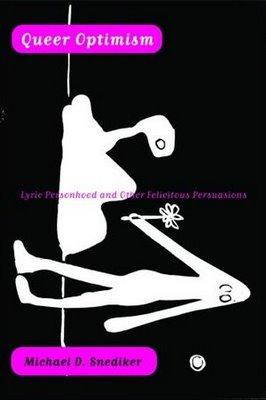Queer Optimism: Lyric Personhood and Other Felicitous Persuasions

“The year I told my parents I was gay was also the year of my first encounter with depression,” writes Michael Snediker in the opening line of his detailed introduction.
This line struck a nerve as I know a few people who, personally, are still on the same boat. I have seen an aunt and an uncle, a lesbian and gay respectively, ostracized by the conservative, über-religious society they live in. They have suffered self-doubt, identity crisis, and depression the moment their secrets have been revealed.
Snediker’s scholarly work Queer Optimism: Lyric Personhood and Other Felicitous Persuasions aims to counterpoint the negativity that revolves around queer theory, which is often melancholy, self-shattering, shame and death driven, with the help of poetic lyrics coming from Hart Crane, Emily Dickinson, Jack Spicer and Elizabeth Bishop. The author’s queer optimism “doesn’t aspire toward optimism,” rather “to find happiness interesting.”
He chose the aforementioned poets as there is more to their work than their melancholic poetics; that deep inside there hides a smile that has a long-lasting effect on anyone who might want to read beyond their quatrains. It seems to be an ambitious task. By using different theories (from Michel Foucault’s to Judith Butler’s) and other bodies of work from literary critics, Snediker successfully managed to give his readers fresh views on the poets’ selected literary works to search for the ultimate quest for enjoyment and personhood.
For example, when most of the literary critics were convinced that Crane’s last work, "The Broken Tower," suggested his impending death, which they all agreed showed “deeper insight and wisdom” than his earlier poems, Snediker refuted that there was another oeuvre that could be written at the same time of his intended last poem, "The Circumstance," that salvaged the “broken stones” that “were dismantled” in "The Broken Tower." Meaning, behind the sadness of Crane’s there lingered his own optimism. Perhaps. Crane, who committed suicide in April 1932 by jumping into the Gulf of Mexico from the steamship SS Orizaba, regarded himself as a failure, partly literary and partly due to his homosexuality. His critics saw his works as difficult to understand. Yet, in the 1930s America, Crane was one of its victims: misunderstood and gay.
Snediker, an assistant professor of English at Queens’ University in Ontario, Canada, didn’t arrange his chapters chronologically, instead thematically, with each chapter relating to each other. Hence Dickinson went after Crane’s.
As a childhood favorite, I was aware of Dickinson’s masochistic tendencies. Her dedication to producing poems engorged with pain, dying and death always made me smile. This drove Snediker to probe through her works.
He also posed some questions concerning Spicer’s serial poem Billy the Kid could be his own way of struggling with his own identity. Could it be the poet’s “aggression against himself?” or some “internalized homophobia?” Was the poem about the poet’s fascination with multiplicity, the character’s ability to elude death? The famed Billy the Kid who always comes back through the numerous films where he kills and dies again and kills and dies again greatly inspired Spicer. He, by the way, was a reader of Dickinson.
How about a connection, not a spiritual one but in terms of idealization, between Crane and Bishop? Was this a sort of queer love on the part of Bishop, who never mentioned her homosexuality throughout her works unlike her contemporaries’ confessional poetry? Did she think of Crane when she composed some of her works?
These are only tips of the iceberg, if you may call them. I have learned so many things after reading Snediker’s book; it is like a new world opening up with so many perspectives and possibilities. I remember a discussion with a friend years ago about poetry: the beauty of reading poems is that it is open for interpretation. Everyone can draw his or her own conclusion. There are no boundaries.
What’s also good about Snediker’s Queer Optimism is that it is not only the homosexual community that can profit from it, but all of us, who possess different colors and sexual orientations, because pain, love, and happiness are universal.
dear mr. snediker, i was simply bowled over by your book. the pleasure is mine.
Dear Elen,
I'm grateful for your very thoughtful review.
May our paths cross in the offing.
With many thanks, sincerely, Michael Snediker